Adrian Bates has been climbing and documenting in the Costa Blanca region of Spain for many years much of which is covered on his web site Costa Blanca Climbing. In this article Adrian discovers an unexpected style of climbing on one of the forgotten peaks of the area.
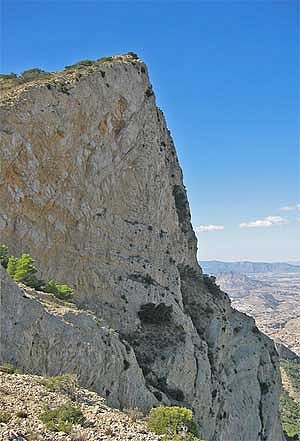
'You see the big square mountain over there? There's a via ferrata on that.', David gesticulated over his shoulder at a very distinctive mountain on the horizon. A via ferrata? In the Costa Blanca? My head spun with images of towering Dolomites with metal steps and chains running up terrifyingly blank faces. I knew the Costa Blanca had bolted routes of superb quality and even massive mountain adventures on trad gear but a via ferrata? My interest had been seriously awakened. I glanced again at the silhouette of El Cid on the horizon. One day, just maybe......
That was back in 2000 and ever since that day I have kept my ear to the ground for further information but it wasn't until the summer of 2004 that I heard more from David Mora Garcia, a professional guide who works for the Mountain Climbing Federation of Valencia. They had been doing a lot of work on the via ferrata to replace some of the older gear and to improve some of the difficult sections. Before I could think too much about it, I had arranged for David to lead a party of us up the route in October. He was even able to supply the necessary lanyards.
A via ferrata route basically involves scaling a mountain without the use of traditional mountaineering skills. Rather than 2 or 3 people climbing with ropes and belay devices, a cable bolted to the mountainside protects the entire route. Where the rock becomes vertical 6" wide metal staples are driven into the rock to form a ladder.
The lanyard is attached to your waist and has two tails that clip onto the cable. These two tails allow you to unclip one tail to move it past a bolt while still remaining protected by the other. Should you fall you will slide down the cable to the bolt below, which may be some distance. To protect the user, lanyards have a built in friction device through which the tails are pulled. This absorbs much of the energy of the fall.
So there we were in the October sunshine with our lanyards attached to our waists staring up at the overwhelming scale of El Cid's North face. And what a stunning mountain it is, a true triangular alpinesque north face rising over 250m above our heads, the vertical rock dotted with metal staples. David happily informed us that the route had become a via ferrata because of the poor quality of the rock. 'Oh great', I thought as I took hold of the first staple and pulled my weight up. 'Don't worry they are drilled in 15cm", David reassured. I stared up at the line of staples and wondered at the sheer amount of work that it represented.
Climbing up on the staples, a simple unclip and re-clip past the bolts, and we were off. A process that felt awkward to start with soon became second nature as we progressed up. 'Loop the tails over your arm', came David's instruction. This made it much easier to reach the clips when required.
Very soon we came to the top of the first short piece of vertical rock and then traversed left below the main face. This brought us to a prominent ramp sloping back up to the right, which had been clearly visible from the base and allowed access to the very heart of the face. Now the main ascent started for real.
As we climbed so the exposure grew, and with it my excitement. Stunning views off to the North clearly showed the climbing crag of Forada surround by some spectacular rock scenery. A huge carved wave of rock sat near it as if challenging climbers to try their luck.
Pulling ourselves up a chain on a slabby ramp we climbed on to a large ledge that approximately marked the centre of the face. We were feeling rather pleased with ourselves. This via ferrata stuff was simple. As if to squash our dangerously over-inflated egos, a plaque on the wall commemorated the tragic death of a previous climber. Suddenly the true scale of this mountain hit me. I had seen these tragic memorials on holidays in the Alps but to see one in Spain....
The climb off the ledge did nothing to boost my confidence. A tricky section was soon surmounted only to reach another that demonstrated the true nature of this rather unstable mountain. The climb led up through a corner of some the worst, most unstable looking rock I have ever had the pleasure of climbing. I couldn't help but wonder at the audacity of the people that had first climbed this route using traditional climbing techniques back in the seventies. The true reality of the plaque that we had passed earlier now became clear. I tightened my grip on the metal staples and continued up.
Soon we were making good progress again and spirits soared. Some great bridging moves up a chimney led to a distinctly airy traverse with great photo opportunities and tremendous exposure. And there above lay the top. I can truly say that I was disappointed to see it as I was simply having so much fun I didn't want it to stop.
For someone used to traditional mountain climbing techniques it came as a real shock to realise that we had climbed nearly 300m in less than 2 hours. Climbing with via ferrata techniques means there is no stopping to place protection, no building stances, no bringing up seconds. You climb independently, elated with the simplicity and freedom.
Topping out was a great feeling with David there to shake each of our hands as we scrambled over the top. One of our party yelled, 'This is the best thing I have ever done' and I knew exactly how he felt!
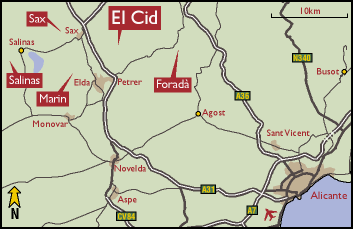
Technical Details
Route length: 300m
Vertical Ascent: 250m
Time for ascent: 2 hours
Time to descend: 1-1.5 hours
Location: Just North of Elda off the main Alicante to Madrid motorway
Equipment Required
Helmet
Harness
Via Ferrata Lanyard
Stout boots (climbing boots are not necessary)
Fingerless gloves (mountain biking gloves are good as their palms tend to be protected with leather)
David Mora Garcia Contact Details
Telephone: 00 34 96 669 76 86
Email: [email protected]

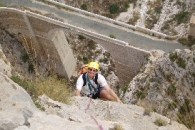

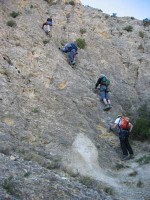
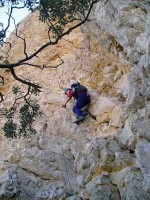
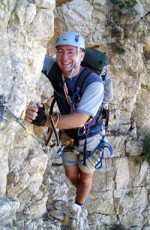
Comments